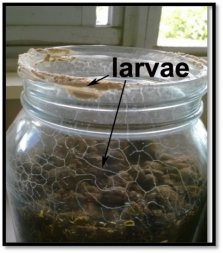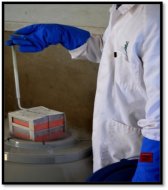Editor’s note: Sheep producers can greatly improve worm control by reducing the number of worm larvae on pasture, and WormBoss describes how to do this with grazing management practices (see Your program > Grazing management). This article by Jane Lamb gives a fascinating insight into the world of worm larvae.
Avoiding or maintaining very low numbers of worm larvae on pasture makes for very effective worm control, so an understanding of larvae and how they develop can help to manage or control larvae on pasture.
Once eggs are deposited in faecal pellets on pasture and conditions are suitable for development, the eggs hatch to larvae (L1 or first-stage larvae), then undergo two moults to become the infective third-stage larvae (L3).
If conditions are suitable for larval development, the number of infective larvae that can develop within a short time period is surprisingly high, especially with the high egg-producing Haemonchus contortus (barber’s pole worm). As seen in Figure 1, a 24-hour faecal collection from just one donor sheep infected with H. contortus (WEC of 4000 epg), cultured and incubated for 7 days at 25–27°C, produced approximately 800,000 infective larvae; larvae that could potentially infect the sheep.

Identifying L3 species is difficult and can only be performed by trained laboratory personnel using a microscope with high magnification. Identification is based on morphological features (the specific anatomy of each species), in particular, the length, head, and tail differences. When monitoring WECs, this additional larval culture test will differentiate the species in the sample.
Larvae are very resilient and can survive low temperatures, including winter frosts, and remain viable and infective on pastures for many months.
In the laboratory, infective larvae are stored alive in a refrigerator. Teladorsagia spp., Trichostrongylus spp. and Nematodirus spp. L3 larvae can withstand cooler temperatures and are stored in water (they don't drown) at 5°C in the laboratory with still many viable at 5–7 months. In contrast, H.contortus L3 larvae is one species which is more sensitive to temperature and will store viable for only 3-4 months at 10°C in the laboratory.
By the time larvae reach the L3 infective stage, they have developed a protective external sheath, an attribute that gives them the resilience and ability to survive over a range of climatic conditions. At this stage the larvae do not feed, but survive on reserves that have been stored in development. In warm, humid conditions the larvae are more active and will have a greater demand for their limited food reserves. Whereas, in cooler temperatures, the larvae are less active, consume fewer reserves and so will survive longer on pasture. When the larvae are finally ingested by a grazing animal, this protective sheath is shed or ex-sheathed (Figure 2) and larvae resume feeding in the host to develop to the adult worm.
Larvae generally hatch from the egg to undergo development to L3. One exception, however, is the Nematodirus spp., which develop to the infective third-stage larvae within the egg, as seen below in Figure 3a.
Unfortunately, larvae on pasture cannot be viewed with the naked eye and so the degree of contamination and the distribution on pastures is not evident, nor is the particular worm species, which can vary in pathogenicity (disease-causing ability) to grazing animals.
Conducting worm egg counts with larval cultures periodically and understanding the conditions under which those worm eggs can develop to infective larvae in the field provides a picture of the worm-risk of a paddock. Highly contaminated pastures are particularly unsuitable for young or naïve and immunosuppressed sheep, which are at most risk to infection.
The extent of pasture contamination with worms can also be managed by rotational grazing programs.

Whilst producers are endeavouring to keep sheep free of worm burdens, Veterinary Health Research (VHR) has a Larval Propagation program using naïve sheep (and cattle) to propagate large numbers of specific L3 strains that are anthelmintic (drench) susceptible or resistant (or multi-resistant). These larvae are subsequently used in clinical trials, artificially infecting test animals to confirm effectiveness of anthelmintic products, to establish product label claims and subsequent registration.
Furthermore, as these L3 larval strains are so important to the industry for testing and the development of new anthelmintic products, retaining specific strains cryopreserved in liquid nitrogen (-196°C) accommodates long-term storage of L3 for future use (+30 years).